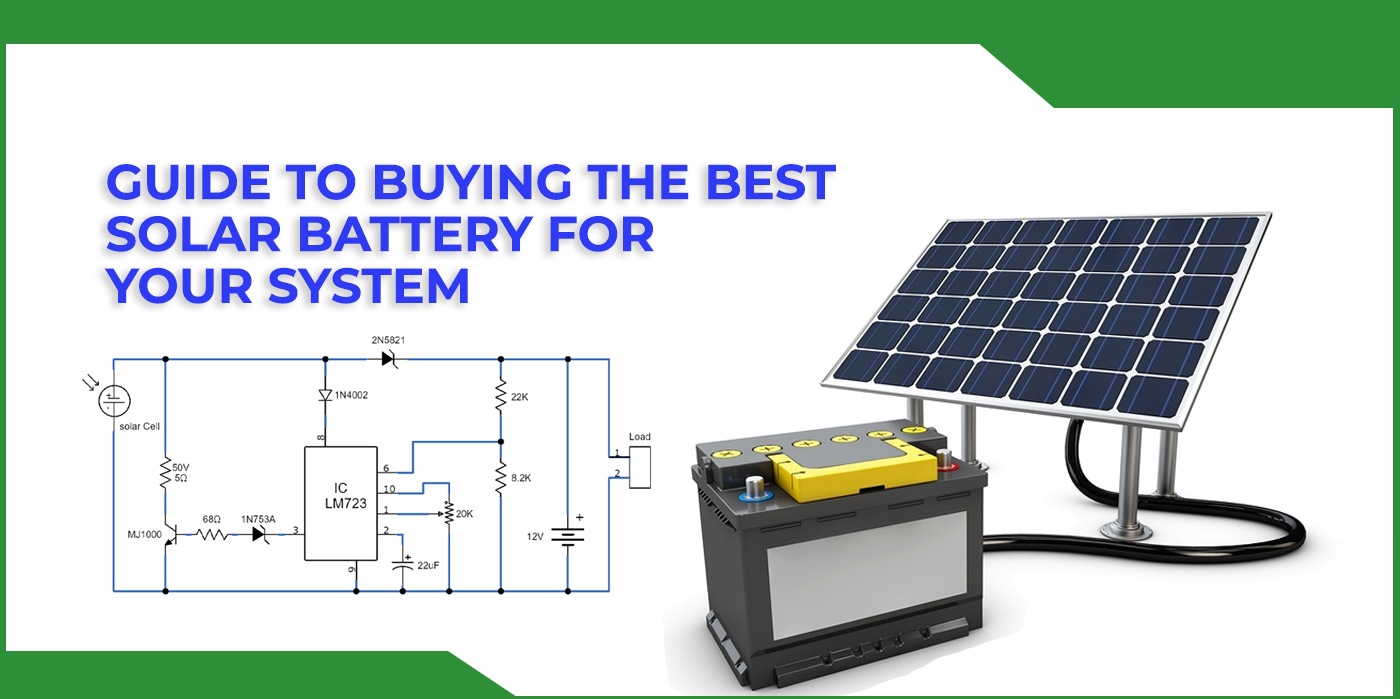Solar Batteries, Solar System
Guide to Buying The Best Solar Battery For Your System
solar battery is a gadget used to store the overabundance of electricity created for some time in the future. Solar batteries are really famous for homegrown use. Since they remain forever inseparable from solar boards, they frequently go about as backup when solar boards don’t create sufficient electricity. In any case, a great many people don’t have any idea what variables to consider while buying solar batteries. Buying solar batteries, particularly interestingly, can be precarious. The fundamental justification for this is on the grounds that different solar batteries have been created for various situations.
Things To Know Before Buying A Solar Battery
Along these lines, to assist you with reducing your decisions for what sort of battery is best for your solar energy framework, here are some center elements that will assist you with understanding what you need and need.
Capacity And Power
Capacity or size is the aggregate sum of energy put away in the battery. The estimation of capacity is kilowatt-hours (kWh). While power is the current or electricity provided by the battery estimated by Ampere (Amps) or kilowatt (kW). The capacity and power of a battery impact the time the battery will run. For instance, a 10 kWh capacity solar battery with a 5 kW power will run for 2 hrs.
How much power is used in a day generally relies upon your electrical machines?
Weighty consuming electrical apparatuses like coolers and microwaves will more often than not drain your battery’s power rapidly. This is on the grounds that these apparatuses need high current. A battery with a powerful rating and a low-capacity rating supplies electricity for a more limited time frame. To expand the time supply of electricity, you can add a few powerful batteries. Assuming that you have numerous electrical machines, powerful batteries are awesome. A battery with a low power rating and a high capacity can supply electricity for expanded periods. In any case, this applies where there are a couple of non-consuming machines. Knowing the capacity or power of a solar battery is really simple. You should simply take a look at the capacity and power ratings. Two sorts of capacity are ostensible capacity and usable capacity. Ostensible capacity shows the aggregate sum of energy the solar battery can hold.
Then again, usable capacity shows the real measure of energy the battery can store. Most battery limits range from 2 kWh to 10 kWh. There are additionally two kinds of power ratings, continuous and instantaneous. Instantaneous power rating is otherwise called 5 – moment or pinnacle power rating. As the name recommends, the continuous rating shows how much current the solar battery can supply reliably. The instantaneous power rating shows the aggregate sum of current the battery can supply without a moment’s delay. The power ratings assist you with dealing with your electrical machines better relying upon their consumption. The power rating scope of most batteries is between 5 kW and 7 kW.
Battery Chemistry/Battery Type
While considering the chemistry of your solar battery, check the components it contains. The parts contained in every battery are unique. Besides, the parts decide specific things like capacity. The fundamental sorts of solar batteries are; Flow batteries, Lithium-ion batteries, and Lead-acid batteries. An ever-increasing number of solar batteries are being acquainted consistently due to propelling innovation.
Lithium-ion Batteries
These are the most normally utilized batteries, their focal part being Lithium. Lithium-ion batteries convert put away synthetic hybrids into electrical energy. Everything starts when lithium ions discharge electrons. The ions flow from the adversely charged anode to the emphatically charged cathode. The electrolytes present in these batteries work with this development. Lithium-ion batteries are utilized in practically any electrical device, from cell phones to electric vehicles. The fundamental sorts of these batteries are Lithium iron phosphate (LFP) and Lithium nickel manganese cobalt oxide (NMC). NMC batteries enjoy various benefits like being more power-thick and less expensive. Be that as it may, they are inclined to overheating, also called warm out of control. Because of overheating, their duration will in general be more limited. There is additionally the gamble of natural pollution. LFP batteries, then again, are enduring and need natural dangers. LFP batteries likewise have coolers that forestall overabundance intensity and cold. Coolers fundamentally decrease mileage. The main difficulty is they are over the top expensive.
Flow Batteries
These batteries are otherwise called redox flow batteries. Flow batteries function utilizing electrolytes. No metal compound is expected to move electrolytes as they use fluids. These batteries have not been in that frame of mind for a really long time. In any case, they have great holding power contrasted with other battery types. Their life expectancy is very lengthy as well.
Lead-acid Batteries
Lead-acid batteries are superior to some other batteries for off-lattice functions. Notwithstanding, they take too long to even think about charging. These batteries use lead parts to function. The arrangement is two positive and negative plates suspended in an electrolyte. The electrolyte solution helps with moving electrons from one plate to the next: the thicker the plates, the more sturdy the battery. Lead-acid batteries are notable for their utilization in vehicles. A more noticeable sort of lead-acid battery is the Tubular battery. Tubular batteries are tracked down principally in the city edges. They have a more drawn-out life expectancy of 3 to 4 years than lead-acid plate batteries. They likewise have higher charging and releasing power. Lead-acid batteries can either be overflowed or fixed. Overflowed batteries have an electrolyte solution that should be topped up each now and then. Fixed batteries need expulsion covers and require no filling.
Round-Trip Efficiency
This is how much energy is present in regard to how much energy is utilized by the operating arrangement of the battery. Some energy is continuously used inside the battery while conveying the energy. Checking the round-trip efficiency of a solar battery prior to buying it is fundamental. Continuously buy a solar battery that has a high round trip efficiency. Guarantee that you are not losing additional energy that your machines might have used. For instance, assuming the battery put away energy is 10 kWh yet the energy conveyed is 8 kWh. Then the round trip efficiency is 80%. The battery’s operating framework uses 2 kWh. While buying solar batteries, consistently check to assume that it is AC coupled or DC coupled. You would rather not buy solar batteries that don’t match the wiring of your solar board. In AC coupled storage, there are different energy changes. While in DC storage, the conversion of energy happens just a single time. The most widely recognized storage framework is the AC coupled framework. In AC storage, AC electricity is first switched over completely to DC electricity. DC electricity is generally used by electrical machines or fills different needs.
The excess measure of electricity is subsequently changed over completely to AC and put away. The put-away electricity will again be switched over completely to DC during utilization. The different conversion of electricity consumes a great deal of energy superfluously. However, ac coupled storage enjoys a few benefits. It can store everything of energy in solar batteries. It doesn’t make any difference whether the solar boards are accumulating sufficient energy. Propelling your solar framework with an AC framework than the DC system is additionally simpler. The DC-coupled batteries store energy straightforwardly from the solar boards. The main conversion happens when the electricity is conveyed to your electrical apparatuses. This is on the grounds that most DC-coupled batteries have hybrid inverters.
A hybrid inverter is a gadget that switches AC over completely to DC electricity. It functions in both your solar board and solar battery, so there is a compelling reason need to have two inverters. It is profoundly productive as it saves money on purchasing two inverters. Be that as it may, you can buy two inverters, one for the solar board and one for the solar battery. On the off chance that you as of now have a solar board at home, you are probably going to buy an AC coupled battery. This is on the grounds that most solar boards set up before were AC coupled. Be that as it may, assuming you intend to buy a solar board along with a solar battery, it will probably be DC coupled.
Duration And Guarantee
Duration is commonly the way that long the solar battery will endure. Various kinds of batteries have various durations. A guarantee is a composed report by the manufacturer promising to fix or replace a thing. Nonetheless, guarantees have expiry dates. All things considered, let’s attempt to get a decent guarantee before buying. Guarantees that have longer expiry dates are awesome. While assessing the duration of a battery, there are sure factors you ought to consider. Does the battery have inbuilt protection from heat? Provided that this is true, it’s exceptionally tough. Overheating will in general wear out fundamental links leading to fast mileage. How frequently does the battery charge and discharge? In the event that the battery holds the charge for longer, having a long lifespan is probable. We as whole know retention of charge is a fantastic mark of strength in any electronic gear. Different interesting points are normal long stretches of operation and assessed throughput. Throughput is the production pace of the batteries; high throughput is a mark of high solidness. Low throughput is a mark of low solidness. Most Solar Batteries have a life expectancy of 5 to 10 years. Lithium-ion batteries are more solid as they have 10 to 15 years. Lead-acid batteries are the most un-strong, with a life expectancy of 5 years. Then again, Flow batteries can endure up to 30 yrs. The futures of these batteries all rely heavily on how well you keep up with them.
Depth Of Discharge
Depth of discharge (DoD) is the capacity accessible for utilization. It is the capacity you can use serenely without stressing the battery’s framework. Flow batteries will more often than not have a higher DoD contrasted with different batteries. They have 100 percent DoD, meaning you can use this battery until its charge is completely drained. Lithium-ion batteries have a 90% DoD. When you use 90% of its capacity, you ought to re-energize it to forestall harm.
Solar Battery Security
Which solar battery innovation is the most secure one? The most secure one in presence today is lithium iron phosphate battery innovation or LFP. These are exceptionally steady and get no opportunity of overheating. They likewise run exceptionally cool which implies they can be placed inside your home, whenever wanted, and will not need additional ventilation or cooling. The following most famous solar battery chemistry is lithium nickel manganese cobalt oxide or NMC. This sort of battery is additionally broadly utilized and presents practically no gamble of overheating. Nonetheless, they truly do run more sweltering and require additional ventilation. Accordingly, you for the most part don’t need these kinds of batteries in your home. More established solar batteries utilized lead rather than lithium, yet this innovation has generally become undesirable since it is less protected and inclined to spillage as the batteries age.
Solar Source
Solar Source is the top-of-the-line company in providing solar products. We have the best solar products including solar batteries from the world’s best manufacturers. We import high quality products that are tested and proved to be the best in the country. We not only deal in retail but also wholesale selling of solar batteries and other solar products as well. If you want to switch to solar and make your life easier by eliminating bill worries from your life or if you are a solar company needing solar supplies, Solar Source is the best solution for you


